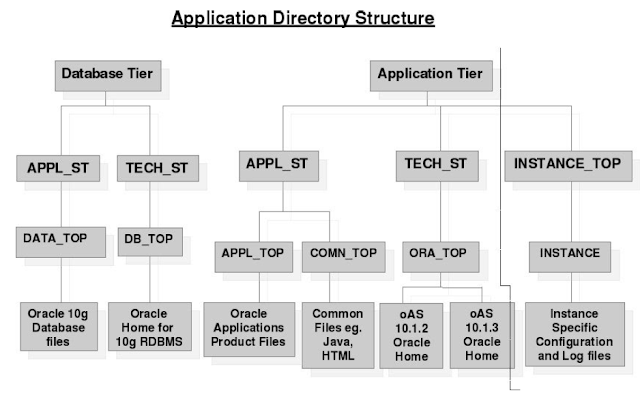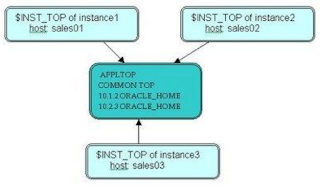Oracle
E-Business Suite (EBS)
§ What is Oracle Applications/Oracle E-Business Suite?
To facilitate
big businesses, Oracle Corporation have created collection of software in the
category of ERP (Enterprise Resource Planning) known as modules, that are
integrated to talk to each other and known as Oracle Applications or E-Business
Suite.
Oracle
Inventory Module deals with the items you
maintain in stock, warehouse etc.
Oracle
Receivables and Oracle Order Management are
dealing with customers like orders given by Customers and Money collected from
customers.
Oracle
General Ledger receives information from all the different
transaction modules and summarizes them in order to create profit and loss
statements, reports
for paying
Taxes etc.
Oracle
Cost Management helps to maintain the costs of items in your
inventory and the immediate modules that it interacts with are Oracle Inventory, Oracle Bills of Material,
Order Management.
§ Oracle E-Business Suite Previous Releases
10.7 : Oldest
Release of Oracle ERP which is character, thin client based. Oracle has stopped
support for this release from year 1998.
11 :
11i :
R12 : Latest
Release Of EBS by Oracle.
§ Oracle EBS R12 Architecture
R12 file system has come up with new model – Code, Data, Configurations are segregated nicely to have easy maintenance, to avert NFS mount issues on shared appl tier configuration systems. Auto-config will not write anything in APPL_TOP, COMMON_TOP area in R12. All instance specific configurations, log files are written in INST_TOP area. Instance Home provides the ability to share Applications and technology stack code among multiple instances.Oracle EBS R12
Applications is a three-tiered architecture.
1. Desktop
Tier
2. Application
Tier
3. Database
Tier
The Oracle
Applications Architecture is a framework for multi-tiered, distributed
computing that supports Oracle Applications products. In this model, various
servers or services are distributed among three levels, or tiers.
First we need
to understand the important points like SERVER, NODE, MACHINE and TIER.
Server: Server is a process or group of processes that run on a single machine
and provide a particular functionality.
Tier: A tier is a logical group of services, which spread across more than
one physical machine.
Machine or node:
A machine is referred to as a node, particularly
in the context of a group of computers that work closely together in a cluster.
Desktop Tier:
The Forms
client applet must be run within a Java Virtual Machine (JVM) on the desktop
client. The Sun J2SE Plug-in component allows use of the Oracle JVM on web
clients, instead of the browser’s own JVM. This is implemented as a browser
plug-in.
Please Note:
In 11i, we use Jinitiator for the for the JVM.
The
Application Tier:
In Release 12,
the application tier contains Oracle Application Server 10g (OAS10g). Three
servers or service groups comprise the basic application tier for Oracle
Applications:
·
Web services
The Web
services component of Oracle Application Server processes requests received
over the network from the desktop clients.
·
Forms services
Forms services
in Oracle Applications Release 12 are provided by the Forms listener servlet or
Form Socket mode, which facilitates the use of firewalls, load balancing,
proxies, and other networking options.
·
Concurrent Processing server
Processes that
run on the Concurrent Processing server are called concurrent requests. When
you submit such a request, either through HTML-based or Forms-based
Applications, a row is inserted into a database table specifying the program to
be run. A concurrent manager then reads the applicable requests in the table,
and starts the associated concurrent program.
Please Note:
There is no concept of an Administration server in Release 12. By default,
patching can be undertaken from any application tier node.
Database Tier:
The database
tier contains the Oracle database server, which stores all the data maintained
by Oracle Applications.
§ R12 EBS Directory Structure
Techstack
Components :
DB_TIER
·
10.2.0.2 RDBMS ORACLE_HOME
APPL-TIER
·
10.1.2 C ORACLE_HOME / FORMS ORACLE_HOME (8.0.6
ORACLE HOME as in R11i)
·
10.1.3 Java ORACLE_HOME/OC4J ORACLE_HOME (iAS
ORACLE_HOME as in R11i)
·
INSTANCE_TOP : Each application tier has a unique
Instance Home file system associated
There are two
versions of Oracle Application server 10g (OAS10g) used,
·
The Oracle Application Server 10.1.2 ORACLE_HOME
(sometimes referred to as the Tools, C, or Developer ORACLE_HOME) replaces the
8.0.6 ORACLE_HOME provided by Oracle9i Application Server 1.0.2.2.2 in Release
11i.
·
The Oracle Application Server 10.1.3 ORACLE_HOME
(sometimes referred to as the Web or Java ORACLE_HOME) replaces the 8.1.7-based
ORACLE_HOME provided by Oracle9i Application Server 1.0.2.2.2 in Release 11i.
(ORACLE EBS R12 ORACLE_HOMES )
Oracle EBS R12
file system has come up with new model - Code, Data, Configurations are
segregated for easy maintenance, to avert NFS mount issues on shared appl tier
configuration systems. Auto-config will not write anything in APPL_TOP,
COMMON_TOP area in R12. All instance specific configurations, log files are
written in INST_TOP area. Instance Home provides the ability to share
Applications and technology stack code among multiple instances.
The image shown
below describes the complete directory structure for complete e-bs installation
i.e. DB_TOP, APPL_TOP and new INST_TOP. If you look into the INST_TOP we will
find that it only contains all the configuration files, start-stop scripts, log
files, certificate files, pid files etc, so as to make DB_TOP and APPL_TOP
untouched for any instance specific changes.
INSTANCE TOP: Instance home is the top-level
directory for an Applications Instance which is known as Instance Home and is
denoted the environment variable $INST_TOP. This contains all the config files,
log files, SSL certificates etc.
Advantages of new INSTANCE HOME:
·
The
additional Instance Home makes the middle tier easier to manage and organized
since the data is kept separate from the config files.
·
The
Instance Home also has the ability to share the Applications and Technology
stack code across multiple instances.
·
Another
advantage of the Instance Home is that the Autoconfig writes only in INST_TOP
so APPL_TOP and ORACLE_HOME can also be made read only file system if required.
·
To
create a new instance that shares an existing middle-tier, just create a new
instance_top with proper config files and NFS Mount the middle tier in the
INSTANCE TOP – STRUCTURE:
$INST_TOP: $APPS_BASE/inst/apps/$CONTEXT_NAME/
/admin
/scripts : ADMIN_SCRIPTS_HOME: Find all AD scripts
here
/appl : APPL_CONFIG_HOME. For standalone envs, this
is set to $APPL_TOP
/fnd/12.0.0/secure : FND_SECURE: dbc files here
/admin :
All Env Config files here
/certs : SSL Certificates go here
/logs : LOG_HOME: Central log file location. All
log files are placed here (except adconfig)
/ora : ORA_CONFIG_HOME
/10.1.2 : 'C' Oracle home config, Contains
tnsnames and forms listener servlet config files
/10.1.3 : Apache & OC4J
config home, Apache, OC4J and opmn This is the 'Java' oracle home configuration
for OPMN, Apache and OC4J
/pids : Apache/Forms server
PID files here
/portal : Apache's
DocumentRoot folder
Shared Application Tier File System
We can configure multiple application node machines working with a single E-Business Suite database node. This creation of a “multi-node” E-Business Suite instance is frequently done to lower cost of ownership (many small machines are cheaper than one big one), increase fault tolerance (one machine fails, others do not), or scale the instance (support more users and a greater load).
When configuring Oracle E-Business Suite to use a shared application tier file system, the application tier node can be configured to perform any of the standard application tier services, such as Forms, Web, and Concurrent Processing (Batch).
Note the following definitions:
Node
A node/server/instance is a logical set of processes running on one hardware machine. In a single-node installation of Oracle E-Business Suite, all the Applications processes (including the database processes) run on one node, whereas in a multi-node installation, the processes are distributed across multiple nodes.
A multi-node installation of Release 12 supports both shared and non-shared application tier file systems. An application tier file system consists of:
Note the following definitions:
Node
A node/server/instance is a logical set of processes running on one hardware machine. In a single-node installation of Oracle E-Business Suite, all the Applications processes (including the database processes) run on one node, whereas in a multi-node installation, the processes are distributed across multiple nodes.
A multi-node installation of Release 12 supports both shared and non-shared application tier file systems. An application tier file system consists of:
- APPL_TOP file system (APPL_TOP and COMMON_TOP directories).
- Application tier technology stack file system (OracleAS 10.1.2 and 10.1.3 Oracle Homes).
- Instance Home (INST_TOP) file system. Each application tier has a unique Instance Home file system associated with it.
Service
A service is a functional set of Oracle E-Business Suite application processes running on one or more nodes. Where applicable, the term ’service’ is replacing the more traditional term of ’server’.
Application Tier Services
The following are the major application tier services:
- Root services
- Web Entry Point services
- Web Application services
- Batch Processing services
- Other services
So if you have two nodes,one will serve as Primary Node and other will serve as Secondry Node. You can configure both the Application tier node as follows:
Primary Application Tier Node
A primary application tier node is the first application tier node where the APPL_TOP, COMMON_TOP, OracleAS 10.1.2 Oracle Home and OracleAS 10.1.3 Oracle Home are installed and configured.
Secondary Application Tier Node
A secondary application tier node is an application tier node where APPL_TOP, COMMON_TOP, 10.1.2 Oracle Home and 10.1.3 Oracle Home are visible and configured. The APPL_TOP, COMMON_TOP, OracleAS 10.1.2 Oracle Home and OracleAS 10.1.3 Oracle Home file system is mounted to this node from the primary application tier node, or from an NFS server.
Instance Home
Note : In a shared file system, each application tier will have a unique Instance Home, which should be located on the local file system.
Instance Home
Note : In a shared file system, each application tier will have a unique Instance Home, which should be located on the local file system.
Shared Application Tier File System Architecture
In a shared file system, all application tier files (with the specific exception of the Instance Home file system) are installed on a shared disk resource, which is mounted on each application tier node. Any application tier node can be configured to perform any of the standard application tier services, such as Forms, Web and Concurrent Processing (Batch) services. All changes made to the shared file system are immediately accessible to all application tier nodes.
Shared Application Tier File System Layout
When configuring Oracle E-Business Suite to use a shared application tier file system, an application tier node can be configured to perform any of the standard application tier services, such as Forms, Web, or Concurrent Processing (Batch) services. An application tier will have a unique Instance Home associated with it that cannot be shared with other application tiers. You can configure the services running on an application tier node to match the node’s intended role
Example Shared File System
The following is an example of mount points shared on each application tier node:
- COMMON_TOP: /ebiz/oracle/VIS/apps/apps_st/comn
- APPL_TOP: /ebiz/oracle/VIS/apps/apps_st/appl
- OracleAS 10.1.2 ORACLE_HOME: /ebiz/oracle/VIS/apps/tech_st/10.1.2
- OracleAS 10.1.3 ORACLE_HOME: /ebiz/oracle/VIS/apps/tech_st/10.1.3
In the figure shown below, entitled “Shared Application Tier File System”, Server-appl_node1 is the primary application tier node, and uses the file systems “/ebiz/oracle/VIS” and “/ebiz/oracle/inst”. The file system “/ebiz/oracle/inst” contains the Instance Home, and “/ ebiz/oracle/VIS ” contains the APPL_TOP, COMMON_TOP, OracleAS 10.1.2 and 10.1.3 Oracle Home.
Server-appl_node2 is the secondary application tier node, and the shared file system “/ebiz/oracle/VIS” is also mounted on this node. The file systems “/ebiz/oracle/inst/apps/VIS_appl_node1″ and “/ebiz/oracle/inst/apps/VIS_appl_node2″ are only visible on the respective nodes.
Server-appl_node2 is the secondary application tier node, and the shared file system “/ebiz/oracle/VIS” is also mounted on this node. The file systems “/ebiz/oracle/inst/apps/VIS_appl_node1″ and “/ebiz/oracle/inst/apps/VIS_appl_node2″ are only visible on the respective nodes.






No comments:
Post a Comment